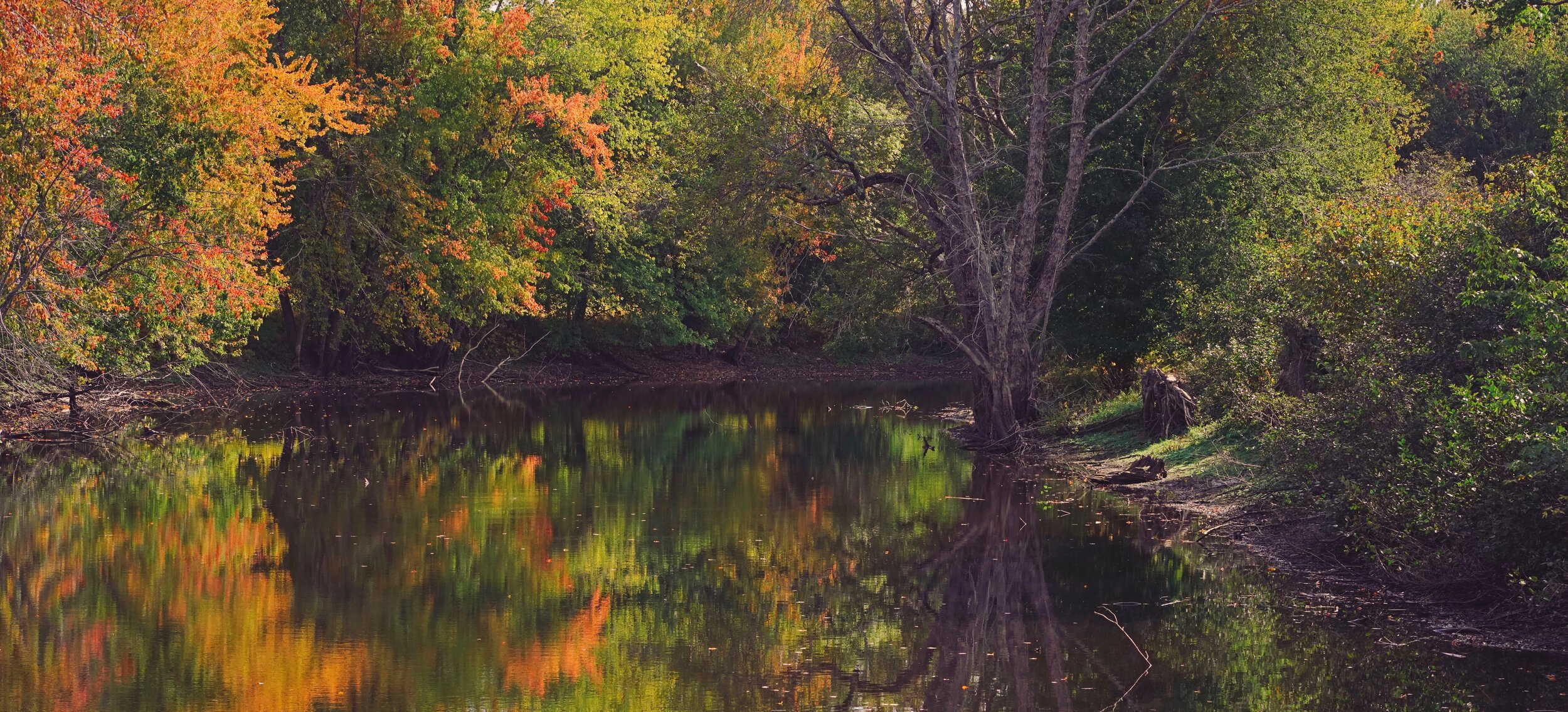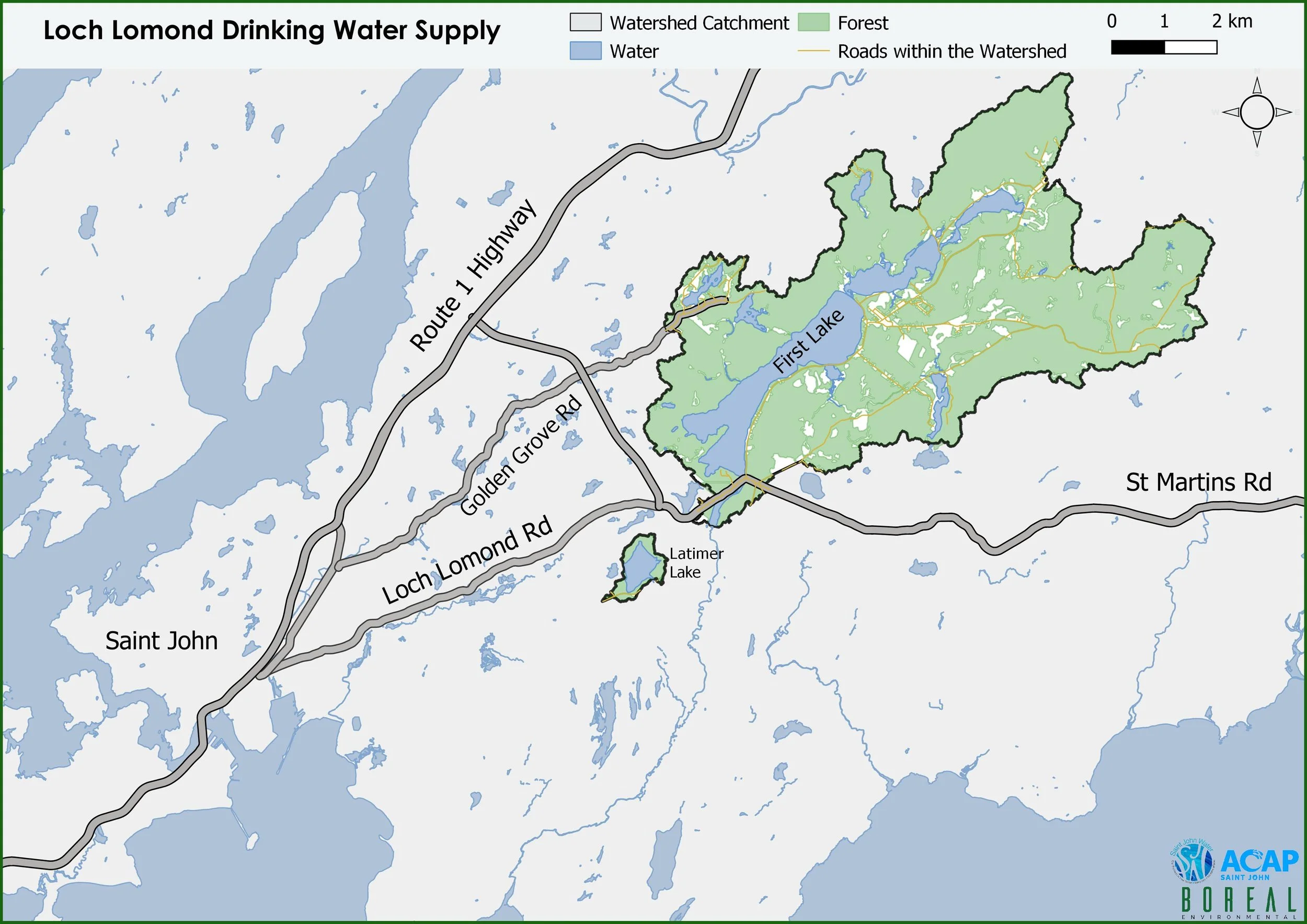What is the Loch Lomond Watershed?
Watersheds are a land area that brings any precipitation from the sky down to streams and rivers, and in turn drain to outflow points such as reservoirs, lakes, and oceans. Essentially, it is a system of water that all drains to one outflow point.
The Loch Lomond Watershed, located is home to Saint John’s source drinking water, and is protected by the New Brunswick Watershed Protected Area Designation Order. The watershed is approximately 1048 hectares in size, and the lakes service the east side, north end, uptown, and parts of the west side.
What is Source Water?
Source water is untreated, or raw, water that is used as drinking water that is provided to public water systems (public drinking water supplies and private wells), by rivers, lakes, aquifers, reservoirs, other fresh water sources, or groundwater. Source water can come from surface water or groundwater.
Surface water includes the lakes and rivers, and water sources on the Earth’s surface, whereas groundwater is the water located in the pores and spaces of rock and soil, and rock fragmentation. Both groundwater and surface water are interconnected.
Essentially, source water is where we get water for our drinking water supply.
Saint John Source Water Locations
The City of Saint John obtains its drinking water from primarily one watershed, and two wellfields: the Loch Lomond Watershed, the South Bay Wellfield and the Harbourview Wellfield.
Loch Lomond Drinking Water Treatment Facility
This facility is supplied from the Loch Lomond and Latimer Lake watersheds. It has the capacity to produce 75 million litres of clean drinking water per day, and the three on-site storage reservoirs have a capacity of 33 million litres. This facility serves customers in the east, north, south, and select areas of the west side of the city. Loch Lomond distribution began in August 2018.
South Bay Wellfield
Three large wells at this site collect water from aquifers deep below the ground's surface. It’s then pumped to the South Bay Treatment Facility for treatment and sent through the distribution system to over 3,000 customers on the west side of the city. South Bay Wellfield began distribution in September 2017.
Harbourview Well System
Saint John Water owns, operates, and maintains two well houses in the Red Head Area in East Saint John. This groundwater system supplies chlorinated well water to a good number of residences in the Harbourview subdivision.
Source water can be compromised by contaminants that enter the water either naturally through the water cycle or are transported through the watershed. Materials that are flushed down toilets or your home’s drains can affect local water quality, and excess stormwater can pick up pollutants and combine with sewage when systems overflow, directly contaminating source water.
Source water protection directly impacts the quality of drinking water. If a drinking water source is highly polluted or poor-quality, it increases your risk of exposure to contaminated water. Ensuring source water is properly protected can help reduce treatment costs and eliminate the need for complex treatments, making safe drinking water more accessible overall.
Loch Lomond Water Quality Monitoring
ACAP Saint John monitors the water quality of the source drinking water. 10 sites across the watershed are monitored monthly from May through December. Water temperature, dissolved oxygen, conductivity, salinity, TDS, and pH are all sampled on site, along with turbidity. Samples are also collected, and then sent to a lab to monitor for a variety of nutrients, from ammonia to E. coli and fecal coliforms. Long term temperature is measured in 4 lakes (Latimer, Robertson, First, and Second) through temperature loggers which remain deployed throughout the monitoring season. Along with the technical sampling, ACAP Saint John visually inspects the 10 sites for any indication of cyanobacteria, litter build up, and environment changes.
Our water quality parameters help to measure the health of the watershed, and to note any changes over time. By monitoring the health of the watershed, pollution prevention and remediation programs can be designed, specific to the various sites. Long term monitoring can tell us whether the work and programs implemented are effective, or whether problems are still emerging.
ACAP Saint John creates annual finalized reports, in collaboration with the Government of New Brunswick and Saint John Water, to ensure mitigation efforts are implemented to continue to protect the city’s largest source of drinking water, and keep treatment costs reduced. This report is readily available to businesses, residents, and customers who want insight onto their quality of water.
2024 Results
Tributary Water Quality:
Total and Dissolved Organic Carbon
Average organic carbon levels during regular monitoring were above the optimal treatment value (4.0 mg/L); however, most sites were below the increased cost value of 7.0 mg/L. Rainfall events observed increased concentrations exceeding treatment costs at all but one site.
E.coli
E.coli concentrations within the tributaries observed during normal monitoring were all below Health Canada’s recreational guideline limit of ≤ 235 MPN/100 mL (Health Canada, 2023); however, during rainfall events (R1-10), all sites experienced an increase in mean E. coli levels, specifically at R4, R5, R8, R9, and R10 which exceeded Health Canada’s recreational guideline limit.
Total Phosphorus and Nitrate
In general, average total phosphorus concentrations during regular and rainfall sampling in 2024 were lower than those in previous years with averages lower than the SDWQGs aesthetic objective of 0.1 mg/L threshold, at most sites, with slight increases during the rainfall sampling events. Average nitrate concentrations were well within the SDWQ guideline thresholds (10 mg/L as nitrate-N) throughout normal and rainfall conditions in 2024.
Lake Water Quality:
Organics and E.coli
Dissolved organic carbon and E.coli concentrations within the source water lakes were generally low, with the lowest value recorded at Latimer Lake which indicate that contaminants are dissipating naturally before entering the treatment facility and overall keeping treatment costs low.
Total Phosphorus and Nitrate
Second Lake observed the highest average total phosphorus values while Robertson Lake had the lowest overall average of total phosphorus. High total phosphorus values at Second Lake may be due the marshy throughfare area upstream of the site.
Temperature
Latimer Lake observed the lowest overall average temperature across depths, measuring 12.82°C. Surface water temperature readings increased from 2023 to 2024 with ambient temperature higher in 2024, which may be impacted by reduced rainfall events. The highest temperatures observed were at Robertson Lake with an average of 16.82°C, and surface water averages measuring 22.98°C during the warmer months and 15.31°C overall. Although these temperatures are expected considering this lake is the smallest and shallowest source water lake within the Loch Lomond Watershed. Generally, water temperatures across all three lakes were well within the range for surface water lakes.
Light Attenuation
Robertson Lake saw the highest overall light attenuation values; this can likely be attributed to its shallow depth. These observations of light attenuation may make this lake more suspectable to cyanobacteria and algae if other conditions are also ideal (nutrients, flow, etc.).
Phycocyanin and Chlorophyll-a and Turbidity
Latimer lake had the highest levels of phycocyanin, chlorophyll-a and turbidity observed in May, while Robertson Lake had the highest levels in August.
What Does this Mean?
Despite elevated levels of E. coli, total phosphorus, and organic carbon concentrations observed within tributaries, these parameters generally remained low within the source water lakes. These results suggest that point sources of these contaminants are entering tributaries and dissipating naturally before entering the source water lakes which help to keep treatment costs low. Spikes in organic carbon are likely due to the surrounding sub-watersheds which consist of old and decaying coniferous forests along with numerous marsh/wetland areas. Spikes in e.coli may be attributed to human activities, faulty septic systems and/or animal activities within the tributaries. Increased phosphorus levels may be associated with the runoff of fertilizers used in gardens, lawns or farms, along with soil erosion, all of which are likely sources within the area.
Although temperatures within the four lakes are normal for the Saint John region, they are still considered warm enough to potentially cause excessive growth of nuisance aquatic organisms, including algal growth, cyanobacteria, and other bacteria such as E. coli.
Loch Lomond Forests and Fire Risk
The Loch Lomond Watershed includes 7617 hectares of vital forested land. The primary species include balsam fir and spruce. Forests play a crucial role in the protection of drinking water sources. The trees surrounding the lakes in Loch Lomond act as a filter and help to absorb runoff and contaminants from the land. In addition, the trees and shrubs will act as erosion prevention, and reduce the amount of sediment entering the water. This is not only beneficial to the aquatic habitats, but helps to limit treatment costs.
On top of endangerment of homes and livelihoods caused by wildfires, fires can negatively impact water quality. By the burning of vegetation, runoff and erosion can increase, as well as sedimentation due to ash accumulation. Despite the vast amounts of forest within the watershed, large sections of the forested land are old and deteriorating due to poor historical management, which can impact their vulnerability to wildfires. Limited variation in tree ages, blown down woody debris, and human activities increase the chance of a wildfire forming. Areas near ATV trails and unofficial bonfire pits/social gathering encampments are at an elevated wildfire risk.
ACAP Saint John is actively conducting tree planting within the watershed to help create a diverse and multi-aged forest. Multi aged forests can provide a wide variety of habitats and enhance the forest’s long-term resilience to environmental stressors, including the escalating challenges posed by climate change.
To help protect your home and the forest from potential wildfires, follow these tips!
Don’t use fireworks at home. In hot, dry conditions, the colorful sparks can turn an exciting celebration into a burning forest in minutes.
Dispose of smoking materials appropriately. Cigarette butts, even when crushed underfoot, can quickly ignite dry vegetation and debris. Soak butts in water until you can dispose of them in a fireproof container.
Choose a safe place to burn. When building a campfire, pick a spot on bare rock/dirt or within a metal fireplace that is sheltered from the wind, at least 3m from overhanging vegetation.
Never leave a flame unattended. An unattended fire can have unintended consequences. At the end of the night, be sure to douse the fire with water, stir around the ashes to get everything good and soaked, and wait until it’s completely cold before leaving.
Keep an eye on your candles. A study by the U.S. Consumer Product Safety Commission found that 85% of candle fires could be avoided if consumers followed three basic steps: never leave a burning candle unattended, don’t put it next to flammable materials, and keep it away from pets and children. (1)
Offroad responsibly. ATV’s and other offroad vehicles can heat up and ignite dry grass. Keep your machine clean and well-maintained, remove debris, double-check your spark arrestor, and let your machine cool down between uses. Avoid driving through fields of dry grass and vegetation, and pack a fire extinguisher or collapsible pail in case of emergencies. (2)
Support forest restoration. Improving the resilience of our forests starts with you! ACAP Saint John hosts tree-planting events as part of our restoration and conservation projects. To learn more, call ACAPSJ at 652-2227, email office@acapsj.org, or follow our socials @acapsj.org.
How Can You Help?
Once a water source is contaminated, it can be costly and time consuming to clean it up or change treatment methods. You can help prevent contamination by properly disposing of harmful materials. This includes avoiding pouring harmful or hazardous materials down the drain, into storm sewers or on the ground, and by properly using pesticides or fertilizers in order not to contaminate source water. These pesticides and fertilizers may contain harmful chemicals which can travel through soil and contaminate groundwater or flow into rivers, lakes and streams. Poorly maintained septic systems release pathogens and chemicals into groundwater which poses a significant danger to public health, keeping your septic system properly maintained can help avoid this.
By ensuring you have a proper buffer zone near wetlands and water sources (75m in a protected watershed), you can help deter contaminated runoff. Tree planting and maintaining the riparian zone along the water body can make a significant difference in source water protection. Riparian tree plantings can prevent sedimentation into the water course (as well as protecting your land) and can help absorb excess nutrients before they hit the water. If you own property within a Source Water Watershed, familiarize yourself with the New Brunswick Watershed Protected Area Designation Order.
Other tips to help protect our source drinking water include:
Proper disposal of risky materials. This includes avoiding pouring harmful or hazardous materials down the drain, into storm sewers or on the ground, and by properly using pesticides or fertilizers in order not to contaminate source water. These pesticides and fertilizers may contain harmful chemicals which can travel through soil and contaminate the water.
Responsible gardening. Only use pesticides and fertilizers as directed on the bottle, and use them sparingly to avoid contaminating groundwater through the soil.
Maintaining your septic tank. Poorly maintained or damaged septic systems can release bacteria and chemicals into groundwater, which can cause significant risk to public health.
Landscaping for longevity. If you own waterfront property, planting trees and shrubs along the shore can help absorb excess nutrients from runoff, and prevent sedimentation and erosion (which will protect your land from water damage!). If you own property within a Source Water Watershed, familiarize yourself with the New Brunswick Watershed Protected Area Designation Order
Planting native species. When landscaping and gardening, consider plants that occur naturally in our region to provide food and habitat for local wildlife. A healthy ecosystem on the shore helps maintain healthy ecosystems in the water, too. This is a great way to increase biodiversity, and attract birds, bees, and butterflies to your backyard!
Keeping it clean. Community clean ups protect both our waterways and community at large by removing garbage and debris from our environment. ACAP Saint John will provide materials (i.e. gloves, bags, etc.) and information on how to organize and execute a successful Cleanup. Call ACAP at 652-2227 or email office@acapsj.org to get started!

LOCH LOMOND WATERSHED
How To Get Involved
Community clean ups can be a great way to not only protect your source water, but protect your community at large. ACAP Saint John will provide materials (i.e. gloves, bags, etc.) and information on how to organize and execute a successful Cleanup. Call ACAP at 652-2227 or email office@acapsj.org to get started!



